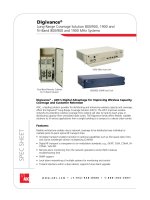Tài liệu networking_solution_at_a_glance0900aecd8062252d doc
Bạn đang xem bản rút gọn của tài liệu. Xem và tải ngay bản đầy đủ của tài liệu tại đây (226.53 KB, 2 trang )
At-A-Glance
What Are Cisco Data Center Networking
Best Practices?
Cisco
®
Data Center Networking Best Practices give
customers guidance and assistance in developing the
data center network architecture most appropriate to
meet changing IT requirements. These best practices
augment the Cisco Data Center Network Architecture
technologies and solutions to help IT architects and data
center professionals take a phased approach to building
and operating a comprehensive network platform for
their next-generation data centers. By taking advantage
of Cisco Data Center Networking Best Practices, IT pro-
fessionals can build a data center–class network, deploy
solutions more quickly with lower risk, facilitate technology
evolution and upgrades, and help ensure that IT staff are
equipped with the right skills and expertise.
Benefits
Build and maintain a data center-class network—
Use validated and documented data center network
solution designs to plan and implement networks
that can achieve the stability and scalability required
for mission-critical data centers. By using proven
best practices, enterprises minimize downtime
and accelerate recovery from disruptions. These
designs also provide a robust foundation that
customers or Cisco Advanced Services can
use to make customizations to meet specific
requirements.
Deploy solutions more quickly, with less risk and
complexity—Use Cisco Data Center Best Practices
to reduce the time, cost, and investment required
for pre-production testing. Tried and tested designs
help avoid the risks associated with technology
disruptions, security exposure, nonscalable designs,
and inappropriate software selection.
Facilitate technology evolution and upgrades—
The data center network is evolving to meet the
challenges associated with cost, business alignment,
•
•
•
resilience, and facilities concerns such as power
and cooling. Cisco Data Center Network Best
Practices are constantly updated to incorporate
these changes, so that customers can adopt them
in a timely manner, with minimal risk.
Accelerate knowledge transfer—The expertise and
skills required to design and maintain increasingly
sophisticated integrated data center networks are
provided through constant training and knowledge
transfer programs and infrastructure services.
These programs include specialized Cisco CCIE
®
training such as the storage specialization, data
center training labs, Cisco Press
®
books, Cisco
Networkers, and executive briefing sessions.
Why Data Center Network Best Practices?
The role of the network in the data center is becoming
ever more crucial; it is evolving into the intelligent
integrated platform for next-generation data centers.
Because it is pervasive and scalable and promotes
standards, the network is developing into a foundation
across which information, application services and all
•
data center resources, including servers, storage are
shared, provisioned, protected, and accessed. With this
in mind, customers need to plan, design, and deploy a
data center network that can provide the highest levels
of stability, performance, and security and can also with-
stand and recover rapidly from disruptions. IT architects
and network planners need to adopt design best practices
to help ensure that the data center network they are
deploying can achieve these goals. They also need
to plan ahead so that the network is designed to meet
today’s requirements and can also transparently evolve
to facilitate the ongoing consolidation, virtualization, and
automation of data center resources,. The best practices
need to take into account the integration of a wide range
of traditional (for example, Ethernet switching and security)
and emerging (for example, storage networking, server
fabric switching, and application network services)
network technologies, as well as non-networking computing,
storage, and application technologies. Most IT organiza-
tions do not have the resources to develop all these best
practices themselves and rely on the expertise and
experience of vendors, consultant, and others.
How Is Cisco Helping Customers with the
Data Center Network Lifecycle?
Cisco gives customers extensive assistance with the
preparation, planning, design, implementation, and oper-
ation of data center networks. This assistance is provided
in two ways: First as a free set of generic best practices
intended to address mainstream data center network
deployments, providing customers with an excellent
foundation upon which to base their own implementations;
and second as services intended to help customers
tailor the network for their specific requirements (Figure
1). These are complementary offerings, which build on
each other and allow customers to use their own internal
expertise or to augment their own capabilities with the
expertise of Cisco Advanced Services specialists.
Data Center Networking Best Practices
Figure 1. Complementary Cisco Data Center Network Best
Practices and Services Offerings
At-A-Glance
Copyright © 2006 Cisco Systems, Inc. All rights reserved. Cisco, Cisco IOS, Cisco Systems, and the Cisco Systems logo are registered trademarks or trademarks of Cisco Systems, Inc. and/or its affiliates in the United States and certain other countries. C45-385183-00 12/06
Data Center Networking Best Practices
Cisco Data Center Networking Best Practices—
Cisco provides data center best practices through
the Cisco Validated Design Program. This program
offers validated and certified designs:
Cisco Validated Design (CVD) 1 validated
designs—These designs identify a system that
has been validated through architectural review
and proof-of-concept testing. Designs at this level,
developed by Cisco technical solutions engineers,
follow a baseline development methodology
and have been approved by engineering,
marketing, services, and sales operations to
meet the desired criteria. Validated designs are
architectural best practices that can be used
by customers to design their own data center
networking architectures. They incorporate
emerging technologies or technology refreshes
that customers may not yet have experience with.
Validated designs provide a baseline for additional
customer-specific proof-of-concept and pre-
production testing.
Cisco Validated Design (CVD) 2 certified
designs—These designs, based on the Cisco
Data Center Assurance Program, identify a system
that has undergone architectural and customer-
relevant testing. Designs at this level both meet
the requirements of a CVD1 validated design
and are certified to a baseline level of quality
that is maintained through ongoing testing and
automated regression, for a common design
and configuration used by leading customers.
Certified designs are architectural best practices
that have been reviewed and updated with
appropriate customer feedback and can be
used by customers with a similar environment,
with minimum additional proof-of-concept or
pre-production testing.
•
˙
˙
Certified designs are supported with forward-
looking roadmaps and system test programs,
which provide mechanisms to promote adoption
of new technologies and designs that maximize
customers’ return on investment (ROI) while
minimizing the operational effects of integrating
new technologies. CVD 2 certified designs
provide customers with a high degree of
confidence in the system-level integrity and
production readiness of the design. In addition,
ongoing testing of new software images and
extended software maintenance versions helps
ensure the sustainability of the design. They
also provides customers with regulatory support
such as Sarbanes-Oxley and Basel II vendor test
support and documentation, The availability of
the completed test reports provides a high level
of transparency and allows customers to better
analyze any risks associated with their specific
deployments.
Cisco Data Center Networking Services—
Cisco augments its data center networking best
practices by offering services that provide
business and technical assessments to help
customers identify gaps between current and
future states. The services promote network
architectures that effectively meet customers’
objectives and help customers achieve reliable
implementations. Customers benefit from
end-to-end processes and planning, reducing
customer risk by deploying validated designs.
Cisco also offers network optimization services,
making it easier to plan changes and major migra-
tions and improving ROI through faster recon-
figuration and integration of new applications
into the data center infrastructure. Customers
can augment internal operation staff with onsite
˙
˙
technical support to resolve problems rapidly and
to transfer knowledge to the internal support
organization.
Why Cisco?
Cisco is in a unique position to offer the comprehensive
best-in-class data center networking technologies, best
practices, and services required to satisfy customers’
immediate and ongoing infrastructure requirements. Cisco
helps customers successfully plan, deploy, and operate a
data center-class network by sharing expertise, experience,
and best practices resulting from extensive solution-level
lab testing, numerous real-world deployments, and partner
engagements. Cisco enables customers to take a phased
architectural approach to attainment of a next-genera-
tion data center, by providing a coherent strategy, vision,
and roadmap and delivering network products that are
designed to be modular, extensible, and interoperable. By
taking this approach customers can achieve investment
protection and incremental value from project to project.
Additional Information
Cisco Data Center Network Architecture:
/>Cisco Data Center Design Guides:
/>ns394/ns224/networking_solutions_design_guid-
ances_list.html
Cisco Storage Network Services:
/>ps2961/ps3010/serv_group_home.html
Data Center Networking Services:
/>serv_group_home.html
•
•
•
•









